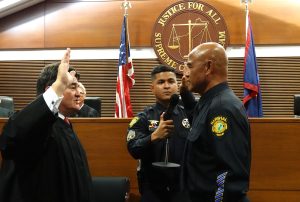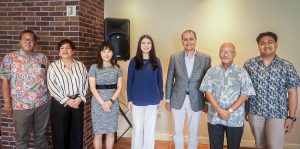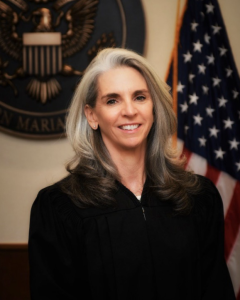Master blacksmith returns to Saipan
Guam master blacksmith Francisco Lizama and Dr. Michael Bevacqua conducted presentations about blacksmithing at the Joeten-Kiyu Public Library last Aug. 27.
The grandfather of Bevacqua, master blacksmith Joaquin Florence Lujan, who unfortunately passed just last year, taught Lizama the ways of blacksmithing.
“We basically told the story of his grandfather who taught me. He was a master blacksmith. Unfortunately he passed away last year, so now I’m the master blacksmith. We talked about the different tools that we brought,” shared Lizama on what they discussed during last weekend’s workshop at the JKPL.
Lizama wishes that the culture of blacksmithing would live on along with the memories of the past master blacksmiths of his time.
“When I was here in 1990, I knew that there were two blacksmiths here. They both passed away and basically the art of blacksmithing kind of disappeared. My purpose is to revive that and bring up the culture that the two made before they died,” he said.
Lizama stressed the importance of blacksmithing through a quick history lesson. “The tools they were working is what the Chamorro people and the Carolinian people used to make a living with.”
He also pins his hopes on the enactment into law of a bill establishing a cultural center in the CNMI. House Bill 19-127, authored by Rep. Felicidad Ogumoro (R-Saipan), recently passed the House of Representatives and is currently in the Senate where it has been referred to a committee for review.
The planned cultural center will feature blacksmithing among other indigenous practices.
“We told them that if they’re interested, if there is enough interest in the Marianas, then maybe the Senate might approve the bill or whatever so that I can come over here and teach,” said Lizama.
There are upcoming presentations for those interested in the near future, but certain dates and venue locations are yet to be specified.
“I have one more presentation here in September. We are also going to Rota and Tinian. No confirmed date and venue for the next presentations as I have yet to coordinate with Dr. Bevaqua,” said Lizama.







Are the two Guamanians who are basically shipwrecked in their culture good resource people to define what is cultural for the NMI? Kidding, huh?
Master blacksmith Joaquin Lujan, who we called Tun Jack, was a Chamorro cultural treasure. He learned his trade from his father who learned it from his father. The tools these men made were important in the everyday lives of the Chamorros of Guam. We still have some of the machetes that we used on the farm on Guam where our family sustained itself for generations, before, during and after the war. There are no machettes that can match them anymore. Also kumzu, teras pugua, fucinas – these were part our everyday Chamorro life starting from the Spanish era. Pretty much every Chamorro family on Saipan and Tinian can trace back to their Guamanian ancestor who moved back to Saipan and Tinian. So these tools are their history too.
Until you could spell it right, e.g., kamyu yan fusiñus only then would there be credence in your assertion. Isn’t language the cultural vehicle?
Really? You’re going to critize my spelling of Chamorro words? My grandparent’s generation spelled Chamorro words using the Spanish alphabet. In the 1970’s or 19980’s the Guam Chamorros decided on a completely new alphabet and way of spelling that was ignored here in the CNMI for years. Pick up some of the Chamorro dictionarys and check – they spell words differently. As a result of all this confusion, Chamorro spelling is all over the map. Even Chamoro is spelled differently (Chamoru). Is one wrong? Depends on who you ask. Until it settles out and we start teaching Chamorro reading and writing in the schools on all islands using the same alphabet and grammer rules, and that isn’t happening, we can only do our best.
Buenas Ioanes,
Maybe during the early stages of learning, he was taught to speak the baby Chamorro linguahi. It is called the Chamorro wannabe and now he is trying dictate our future and way of life.
Si Yu’us Ma’ase
Yeah Jun, the public should follow your recommendation that we give our islands away to the military so they can blow them up. That’s a great way to be good cultural practicioners.
Eh, the only beneficiaries are the presenters. Us? Ace and TrueValue are available for our tools!
Chamole, I am unsure how to take what you stated as “Pretty much every Chamorro family on Saipan and Tinian can trace back to their Guamanian ancestor who moved back to Saipan and Tinian.”
Are you saying that Chamorro’s in CNMI are actually from Guam?
Absolutely. The Chamorros were all forced by the Spanish to leave their homes on every island except Rota, and move to Guam under their policy of “Reduccion”. The Spanish had just defeated the last of the resisiting Chamorros and wanted the people on Guam for labor. The governors used the labor for agriculture to sell to the Manila Galleons. Later, when the Spanish became worried about the English and other European colonists taking islands to the north, they gave land grants to encourage Chamorros to move back to Saipan and Tinian. That’s why so many CNMI familes are so closely related. Other Chamorros also moved back. Not so many from Rota, but some. All others came from Guam.
Buenas Chamaole,
You must been reading to much information on the web and at times it would mislead you. You are arguing with your close relative or your uncle above and he has a point. Your grandfather used to tell me to listen to the wise men or my elders, because they have more knowledge than I when it comes to life in general. When it comes to our culture and heritage, Ioanes is the most knowledgeable or the most inform person. It is useless to argue with your elders, because they are well educated and they know what they are talking about. It was an insult for you to say that our lineage came from Guam, because not all of our people on Saipan, and Tinian were exterminated by your so call “Reduccion.” Maybe you should visit the archives in Spain relating to our people during the Spanish Occupation and you may have a better understanding.
Si Yu’us Ma’ase
Whatever you say Jun. No use having a discussion with you about anything – the result is always the same. You start with “Buenas”, then there is some nonsense that usually includes a few insults, and ends with “Si Yu’us Ma’ase”. Anyway, for your improvement, here’s a very well cited article on Chamorro history and the Spanish policy of Reduccion.
http://worldhistoryconnected.press.illinois.edu/10.3/forum_wiecko.html
Buenas Chamaole,
Thanks for the info. you provided me above. You had no idea what we had to go through in past, because we were considered second class by the people of Guam. You have no clue what Ioanes was trying to say above, but again thanks for the constructive criticism. You may want to visit the archives in Spain relating to the people of the CNMI during the Spanish occupation. Your article above has nothing to do with the Northern Islands. Hint, hint, the Carolinian has a lot to do with the CNMI Culture and they are part of us.
Si Yu’us Ma’ase
May you please clarify, why would an individual a new comer to the CNMI fight for the right of the Chamorro and at the same time allow his wife to disrespect his side of the family? It was an insult for a close relative to informed me of what had been happening.
Respetu to our elders and especially to our close family is the teaching of our elders. If you don’t practice the fundamentals of our culture, please refrain yourself from telling others what to do relating to our way of life. Maybe, because one was born into a silver spoon, he/she can dictate what he/she wants to do within our society.
Hafa lai Jun! I don’t understand what you are trying to tell me. I am asking clarification from the above blogger and you are asking me “May you please clarify, why would an individual a new comer to the CNMI fight for the right of the Chamorro and at the same time allow his wife to disrespect his side of the family” and about “respetu”. Are you referring to the article itself? Are you explaining that one of the master blacksmith being a “new comer” and his spouse disrespecting her family? Sorry brother but master blacksmith’s personal affairs is not my concern and my business.
Primo,
Sorry for putting you in the dark, but I got my point across and it has to do with someone very close to our family tree.
Sorry for the slow reply. Been traveling.
From the link that I provided earlier:
“Largely due to Quiroga’s execution of reducción and catholicization at any cost to the indigenous people and the landscape, the Spanish removed all remaining Chamorros from the northern Mariana Islands, concentrating the entire population on Guam and Rota.”
Once on Guam, there was a massive drop in Chamorro population from diseases. I think the low point was about 2500 people. I don’t have access to my books right now so I can’t look up the numbers and dates, but my understanding is that those who had been moved to Guam from the northern islands continued to live on Guam for generations before any Chamorros resettled in the north. So they would not be the same individuals who had been forced to move to Guam, but some of them were probably their descendants.